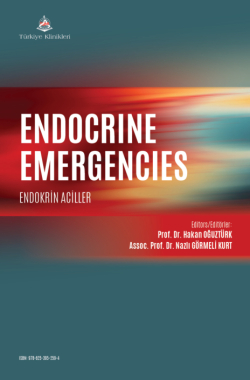Pheochromocytoma and Catecholamine Crisis
Rümeysa BAYAZIT KESKİNa , Fatih Ahmet KAHRAMANa
aAnkara Bilkent City Hospital, Clinic of Emergency Medicine, Ankara, Türkiye
Bayazıt Keskin R, Kahraman FA. Pheochromocytoma and catecholamine crisis. In: Oğuztürk H, Görmeli Kurt N, eds. Endocrine Emergencies. 1st ed. Ankara: Türkiye Klinikleri; 2024. p.58-62.
ABSTRACT
Pheochromocytoma presents in different clinical settings ranging from asymptomatic to nonspecific findings such as hypertension, tachycardia, sweating, headache which may be confused with other diagnoses and even shock. It may occur spontaneously or hereditarily. It is difficult to make a diagnosis in emergency departments, but early diagnosis and initiation of correct treatment is lifesaving, especially in patients with catecholamine crisis. Supporting laboratory tests with imaging findings in suspected patients makes the diagnosis. Curative treatment is surgical, and it is essential to suppress adrenergic activity before surgery.
Keywords: Pheochromocytoma; catekolamines; neuroendocrine tumor
Kaynak Göster
Referanslar
- Farrugia FA, Charalampopoulos A. Pheochromocytoma. Endocr Regul. 2019;53(3):191-212. [Crossref] [PubMed]
- Kakoki K, Miyata Y, Shida Y, Hakariya T, Takehara K, Izumida S, et al. Pheochromocytoma multisystem crisis treated with emergency surgery: a case report and literature review. BMC Res Notes. 2015;8:758. [Crossref] [PubMed] [PMC]
- Tsirlin A, Oo Y, Sharma R, Kansara A, Gliwa A, Banerji MA. Pheochromocytoma: a review. Maturitas. 2014;77(3):229-38. [Crossref] [PubMed]
- Hamidi O, Young WF Jr, Iñiguez-Ariza NM, Kittah NE, Gruber L, Bancos C, et al. Malignant Pheochromocytoma and Paraganglioma: 272 Patients Over 55 Years. J Clin Endocrinol Metab. 2017;102(9):3296-305. [Crossref] [PubMed] [PMC]
- Neumann HPH, Young WF Jr, Eng C. Pheochromocytoma and Paraganglioma. N Engl J Med. 2019;381(6):552-65. [Crossref] [PubMed]
- Türkiye Endokrinoloji ve Metabolizma Derneği, "Feokromastoma ve Paraganglioma," in Adrenal ve Gonodal Hastalıklar Kılavuzu-2022. 2022. p.37-52.
- Brouwers FM, Eisenhofer G, Tao JJ, Kant JA, Adams KT, Linehan WM, et al. High frequency of SDHB germline mutations in patients with malignant catecholamine-producing paragangliomas: implications for genetic testing. J Clin Endocrinol Metab. 2006;91(11):4505-9. [Crossref] [PubMed]
- Sbardella E, Grossman AB. Pheochromocytoma: An approach to diagnosis. Best Pract Res Clin Endocrinol Metab. 2020;34(2):101346. [Crossref] [PubMed]
- La Batide-Alanore A, Chatellier G, Plouin PF. Diabetes as a marker of pheochromocytoma in hypertensive patients. J Hypertens. 2003;21(9):1703-7. [Crossref] [PubMed]
- Baguet JP, Hammer L, Mazzuco TL, Chabre O, Mallion JM, Sturm N, et al. Circumstances of discovery of phaeochromocytoma: a retrospective study of 41 consecutive patients. Eur J Endocrinol. 2004;150(5):681-6. [Crossref] [PubMed]
- Lenders JW, Duh QY, Eisenhofer G, Gimenez-Roqueplo AP, Grebe SK, Murad MH, et al.; Endocrine Society. Pheochromocytoma and paraganglioma: an endocrine society clinical practice guideline. J Clin Endocrinol Metab. 2014;99(6):1915-42. Erratum in: J Clin Endocrinol Metab. 2023;108(5):e200. [Crossref] [PubMed]
- Y-Hassan S, Falhammar H. Pheochromocytoma-and paraganglioma-triggered Takotsubo syndrome. Endocrine. 2019;65(3):483-93. [Crossref] [PubMed] [PMC]
- Kassim TA, Clarke DD, Mai VQ, Clyde PW, Mohamed Shakir KM. Catecholamine-induced cardiomyopathy. Endocr Pract. 2008;14(9):1137-49. [Crossref] [PubMed]
- Greenleaf CE, Griffin LA, Shake JG, Orr WS. Hypertensive crisis secondary to pheochromocytoma. Proc (Bayl Univ Med Cent). 2017;30(3):314-5. [Crossref] [PubMed] [PMC]
- Oshmyansky AR, Mahammedi A, Dackiw A, Ball DW, Schulick RD, Zeiger MA, et al. Serendipity in the diagnosis of pheochromocytoma. J Comput Assist Tomogr. 2013;37(5):820-3. [Crossref] [PubMed]
- Gruber LM, Hartman RP, Thompson GB, McKenzie TJ, Lyden ML, Dy BM, et al. Pheochromocytoma Characteristics and Behavior Differ Depending on Method of Discovery. J Clin Endocrinol Metab. 2019;104(5):1386-93. [Crossref] [PubMed]
- Grumbach MM, Biller BM, Braunstein GD, Campbell KK, Carney JA, Godley PA, et al. Management of the clinically inapparent adrenal mass ("incidentaloma"). Ann Intern Med. 2003;138(5):424-9. [Crossref] [PubMed]
- Araujo-Castro M, Pascual-Corrales E, Alonso-Gordoa T, Molina-Cerrillo J, Martínez Lorca A. Role of imaging test with radionuclides in the diagnosis and treatment of pheochromocytomas and paragangliomas. Endocrinol Diabetes Nutr (Engl Ed). 2022;69(8):614-628. [Crossref] [PubMed]
- Eisenhofer G, Goldstein DS, Sullivan P, Csako G, Brouwers FM, Lai EW, et al. Biochemical and clinical manifestations of dopamine-producing paragangliomas: utility of plasma methoxytyramine. J Clin Endocrinol Metab. 2005;90(4):2068-75. [Crossref] [PubMed]
- Baid SK, Lai EW, Wesley RA, Ling A, Timmers HJ, Adams KT, et al. Brief communication: radiographic contrast infusion and catecholamine release in patients with pheochromocytoma. Ann Intern Med. 2009;150(1):27-32. Erratum in: Ann Intern Med. 2009;150(4):292. [Crossref] [PubMed] [PMC]
- Bancos I, Atkinson E, Eng C, Young WF Jr, Neumann HPH; International Pheochromocytoma and Pregnancy Study Group. Maternal and fetal outcomes in phaeochromocytoma and pregnancy: a multicentre retrospective cohort study and systematic review of literature. Lancet Diabetes Endocrinol. 2021;9(1):13-21. [Crossref] [PubMed]
- Naranjo J, Dodd S, Martin YN. Perioperative Management of Pheochromocytoma. J Cardiothorac Vasc Anesth. 2017;31(4):1427-39. [Crossref] [PubMed]
- Nazari MA, Hasan R, Haigney M, Maghsoudi A, Lenders JWM, Carey RM, et al. Catecholamine-induced hypertensive crises: current insights and management. Lancet Diabetes Endocrinol. 2023;11(12):942-54. Erratum in: Lancet Diabetes Endocrinol. 2024;12(1):e1. [Crossref] [PubMed]

